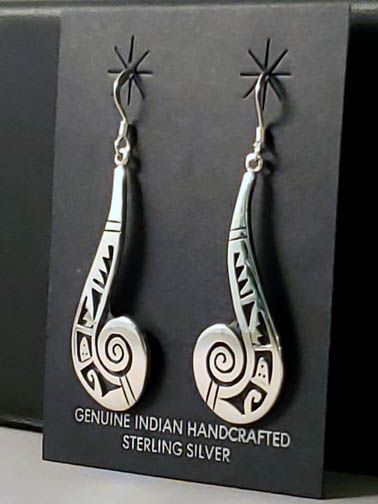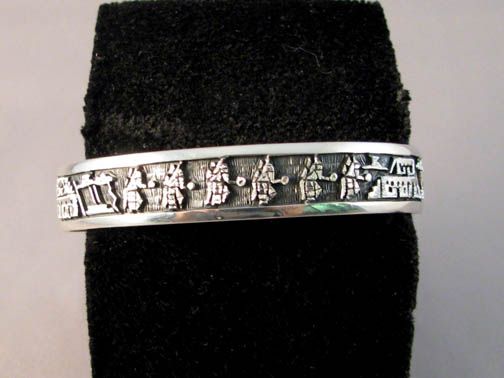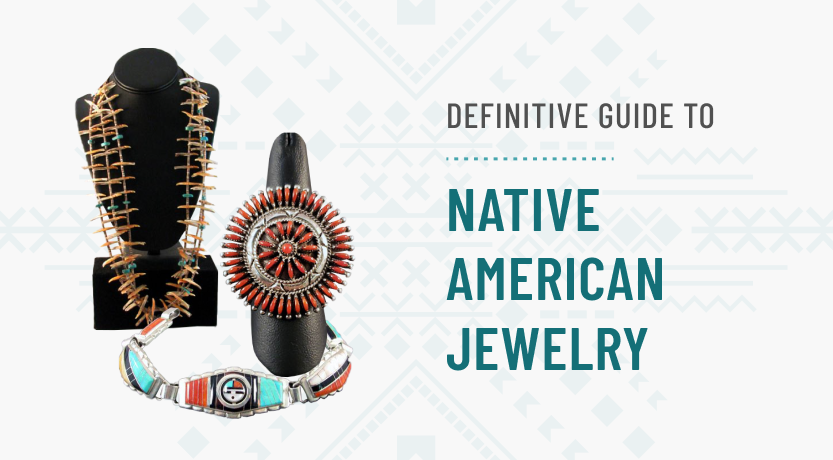
Jewelry plays an integral role in the culture of Native Americans as it conveys stories, preserves history, and symbolizes spiritual beliefs and traditions spanning each tribe throughout North America.
Starting as far back as 12,000 years ago, jewelry-making was born from the local cultures of its respective area. Each unique design featured natural materials found in their surrounding environment to create truly one-of-a-kind pieces.
By trading for necessary materials, Native American tribes were able to craft exquisite jewelry with slight variations in designs. Over time, jewelry-making has evolved into a delicate art form that is still held dear by many tribal cultures today.
Read our guide to learn more about the history of Native American jewelry and what pieces are unique to each tribe. From the tools used to create them, to the meaning behind each design, find out all you need to know about Native American jewelry.
Important Jewelry Pieces by Native American Tribe
Below we have some examples of pieces from different tribes to start you on your own journey with Native American jewelry.
Hopi
The Hopi use traditional basket and pottery symbols in their overlay and applique silverwork. Their jewelry is unique in the high polish of the silver and the deep and intricate overlay work.
Here are some examples of Hopi Jewelry:
Earrings
Overlay technique with water symbols. A great example of the pottery symbols being transformed onto jewelry.

Pendant
This is an example of contemporary work, no symbols, nothing but the simple silverwork and a beautiful stone.
Bracelet/Cuff
The tiny Hopi Longhair Katsinam as well as the pueblo and the rain clouds are an example of extreme detail in overlay work. The Hopi have mastered this technique.
Navajo
The Navajo silverwork was fashioned after the beautiful horse bridles the Spanish used, and later, Fred Harvey purchased stamps for the Navajo to embellish their silverwork. You can see this stamping in concha belts, naja pendants, bench beads, and squash blossom necklaces.
Here are some examples of Navajo Jewelry:
The Bolo
Classic example of concha work with a large stone set in the center.
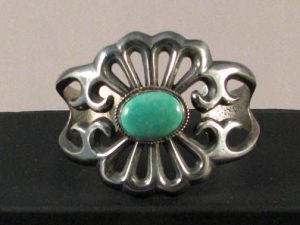
The Bracelet/Cuff
Sandcasting is an ancient technique that the Navajo have mastered. Here again you can see the influence of the conchas used by the Spaniards.
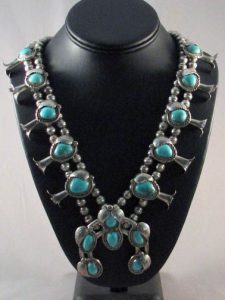
The Squash Blossom Necklace
Traditional Navajo squash blossom with leafwork and handcrafted pearls. This Navajo piece ulitizes large natural turquoise stones and distinctive silverwork.
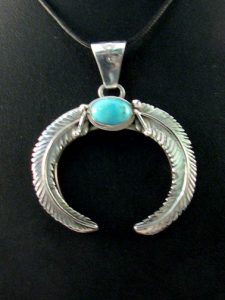
The Naja Pendant
One of the earliest forms of jewelry, fashioned directly from the Spanish headstall. This design was to ward off the evil eye for horse and rider.
Santo Domingo
The Santo Domingo are known for their mosaic work and their tiny heishe beading. These handcut, drilled and polished shell and stone beads are coveted by collectors. The Santo Domingo jewelers still use wood and shell to back many of their beautiful inlay pieces. They do use Sterling silver to wrap and back some of their pieces, and even to use as separators in some of their mosaic work.
Here are some examples of Santo Domingo Jewelry:
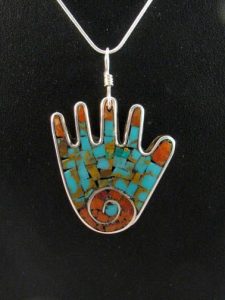
Pendant/Necklace
This Healing Hand pendant incorporates turquoise and coral inlaid on shell and then wrapped in Sterling silver.
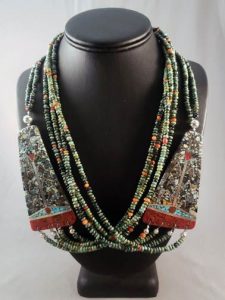
Necklace
This beautiful four-strand necklace was created with handcut New Lander and coral stones and finished with Sterling silver balls that attach to large pendants. The pendants feature Sterling silver cornstalks surrounded with inlaid New Lander and Sleeping Beauty turquoise and apple coral on a mother-of-pearl shell. The back of the shell is etched with a cornstalk. This extraordinary necklace can be worn long or can be doubled and worn shorter.
Zuni
The Zuni create beautifully detailed work in their clusters, using much smaller stones than the Navajo, their pieces are called petit-point or needlepoint. The Zuni are also renowned for their fetish carvings, animal spirits that are central in Zuni life. The animals can be carried in a pocket, set on an altar, placed on display, or worn on a necklace. These fetish necklaces are sought after by collectors. The animals are beautifully carved and the pinshell spacers are handcut and polished. Each piece on the necklace, usually multi-strand, is created by hand.
Here are some examples of Zuni Jewelry:
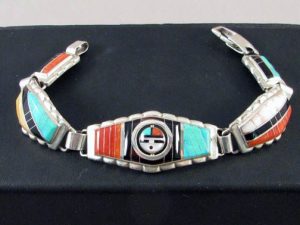
Sunface (Zia)
The Sunface represents one of the most powerful celestial beings and plays a major role in Zuni culture. Stones used to create this piece include mother-of-pearl– intuition and imagination, jet—mother earth, coral– protection and comfort, and turquoise– oneness between the physical and spiritual.
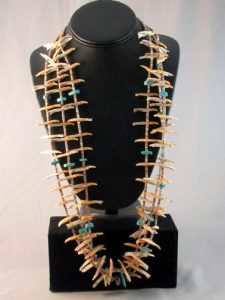
Fetish Necklace
This older piece was created using shell, turquoise and handmade silver beads. The birds are all hand cut from spiny oyster, separated with pinshell and natural turquoise nuggets
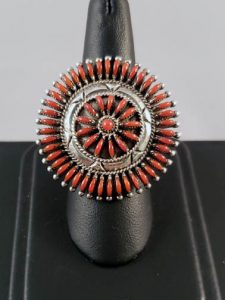
Vintage Ring
This older piece was created using Mediterranean or apple coral.This is an example of needlepoint stonework
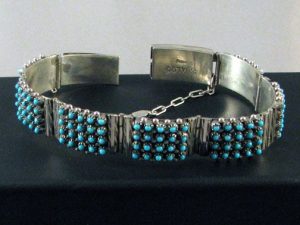
Bracelet
This is an example of petit point work. These are smaller stones and can be cut in a variety of shapes.
A Short History Of Native American Jewelry
When we think of Native American jewelry, the first thing that comes to mind is turquoise. That beautiful blue and green stone has fascinated people all over the world, from the Egyptians (over 6,000 years ago); in Tibet and China (over 7,000 years ago); in Persia, now Iran, (over 4,000 years ago). Turquoise has been used as personal ornamentation as well as currency. Turquoise is found around the world and has been coveted in each culture.
Here in the southwest it was the middle of the 16th century when the Spaniards found the pueblo dwellers in New Mexico and Arizona were using turquoise as ornamentation and trade. The turquoise that was worn was drilled and hung by earlobes with cording or made into beads to wear as necklaces. Some of the pieces were backed with wood, shell, or bone and set in a mosaic fashion using spruce gum as the adhesive. The native people also traded and wore brass or copper, but just as metal slabs or ingots.
Fast-forward to the 1850s when a Navajo blacksmith (Atsidi Sani) first learned silversmithing from a Mexican. He used the blacksmith patterns that were on the Spainairds’ tack to stamp the concha belts and simple silver cuffs. The Native Americans got the silver for their jewelry by melting down U. S. coins. When the federal government made it illegal to deface currency, they switched to melting down Mexican pesos. It still took another 30 years until the craft spread and Navajo and then the Zuni began working with turquoise and other stones set in silver. This began as the desire for Native American jewelry grew.
This was in large part because of Fred Harvey, who in the late 1800s staged “Indian Detours” to show the eastern railroad tourists the Native American way of life and the beautiful jewelry they made. Fred Harvey also gave the silversmiths the stamps to make patterns on their jewelry. These stamps would begin a style of jewelry making that continues today.
Not every tribe worked with silver; it was expensive to get the tools and get started. The Zuni and Navajo had traders, who worked with the federal government, who would front them the tools needed and then take jewelry as payment. This was not an option for the Hopi or the Santo Domingo artists who did not have access to the same programs. The Hopi did not begin to work in silver until the 1900s.
The Santo Domingo people kept to their roots and to this day are known for their mosaic work and their tiny heishe beading. These handcut, drilled and polished shell and stone beads are coveted by collectors. The Santo Domingo jewelers still use wood and shell to back many of their beautiful inlay pieces. The tribal differences seen in jewelry today took time to develop and it was not until the late 1930s when the Coltons, who founded the Museum of Northern Arizona, wanted the Hopi, who have the fewest silversmiths of any tribe, to develop their own distinctive jewelry.
By utilizing Hopi basket, pottery and weaving designs, jewelry designs were created that would set the Hopi apart.
After WWII, when the soldiers returned to Hopi, this distinct style took form. The Veterans Silversmithing Classes pushed the artists to created applique as well as overlay designs that would form the basis for Hopi jewelry today. To recognize the distinct tribal differences in jewelry takes time and exposure to the artists, their culture and their craft.
Types Native American Jewelry
Bolos

The earliest bolo ties were created during the 1930s when the Zuni, Hopi and Navajo men wore large bandanas around their necks tied together with string, and later held with hollowed bone, beads or shell; the first bolo ties. Bolos have been called by many names including slide ties, cowboy ties, gaucho ties and neck ropes. Since the 1930s there have been changes to the bolo tie and it has gone in and out of fashion – always a staple to the Native American people and others who love this Native American art form.
Shop Now
Bracelets–Cuffs

Cuffs as personal adornment and as bow guards have been worn since Egyptian times. Native Americans have gone from simple leather cuffs tied to wrists to keep the bowstring from damaging their skin to elaborate stonework set on stamped or overlay silverwork or even gold. From practical bowguard to showing personal status, blossom cuffs worn in pairs to simple accessories, Native Americans have created an artform that reflects both tribal histories and their outstanding artistic abilities.
Shop Now
Buckles

Large, decorated buckles were used in the 1600s by the military in Europe. Those buckles came to North American with the Spanish and, like the conchas, were something Native Americans adopted and adapted for themselves. Over time the buckles have become a wonderful art space for the Native American silversmith to not only show off his or her talent, but to express cultural values as well. Considering the stonework, detailed overlay and stamping, each piece is a true work of art.
Shop Now
Earrings

Earrings have been worn by men and women as status symbols since the beginning of time. Shell, turquoise, and other stones were hand-drilled, then strung on cording. Once Native Americans got proficient at silversmithing, then began to make thin wires of silver and would loop those through earlobes. Earrings have gone from a simple stone or slab of brass, copper or silver to ornately stamped, or set with stones, or beautiful beads in metal or stone on French wires or posts. Earrings can be small accent pieces or long, flowing pieces that are seen on powwow dancers.
Shop Now
Necklaces

Necklaces are a classic form of personal adornment and status. From simple stone pendants or shell on a leather or cord to beautiful, handcrafted squash blossom necklaces, the adornments are unique. The artistry of Native Americans really shines in necklaces. Not only do they use the symbols of their culture, but they also set those symbols in a beautiful design to be appreciated.
Shop Now
Pins/Pendants

Traditionally pins were not worn by Native Americans, though they would take parts of necklaces or the blossoms from bracelets or cuffs and create pins or brooches for the collector or for the tourist trade. Pendants have been worn as personal ornamentation and spiritual protection as well as status symbols by the Native Americans and now find a place in the collector market. These pieces can be simple bone or a drilled stone on cording or leather or be beautifully created distinctive pendants worn on a neck cuff or chain.
Shop Now
Rings

Rings were worn by Native Americans for ceremonies and as status symbols. They were anything from simple bone to elaborate metalwork with set stones. There is quite a bit of exchange of tribal styles with rings. The Navajo create rings with stamping, leafwork, and silver balls as well as inlaid bands, much like the Zuni. There are many silversmiths who create the same style ring in multiple sizes or individual “showpiece” rings.
Shop Now
Where to Buy Authentic Native American Jewelry
When it comes to Native American jewelry, every piece is unique, conveying a distinctive tale, design, and culture. Wondering where to buy authentic Native American jewelry? Discover your perfect piece in the extensive array of original Native American created necklaces, earrings, rings, bracelets, bolo ties, pins, and pendants at Kachina House. You will be delighted with our wide selection and the beauty and significance of the designs.

